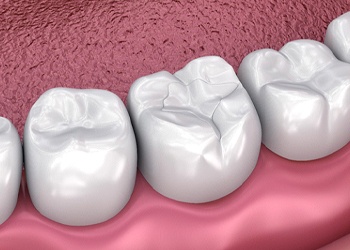Metal-Free Solutions for Cavity Defense
 One of the most common oral health problems seen by dentists is cavities. With a majority of adults having a cavity at some point in their life, it is no surprise that fillings are a frequently used service provided by dental professionals throughout the United States. At Smiles by The Sea Family Dentistry, our team will do our best to keep dental caries from forming; however, should one become apparent and require treatment, we are pleased to provide an alternative to traditional amalgam – tooth-colored fillings. Our dentist in Hampton, Dr. Shevchenko, can repair your weakened tooth and fill it with a solution that blends in beautifully with the rest of your smile. If you think you could benefit from a tooth-colored filling, contact our office today to schedule an appointment!
One of the most common oral health problems seen by dentists is cavities. With a majority of adults having a cavity at some point in their life, it is no surprise that fillings are a frequently used service provided by dental professionals throughout the United States. At Smiles by The Sea Family Dentistry, our team will do our best to keep dental caries from forming; however, should one become apparent and require treatment, we are pleased to provide an alternative to traditional amalgam – tooth-colored fillings. Our dentist in Hampton, Dr. Shevchenko, can repair your weakened tooth and fill it with a solution that blends in beautifully with the rest of your smile. If you think you could benefit from a tooth-colored filling, contact our office today to schedule an appointment!
Why Choose Smiles by The Sea Family Dentistry for Tooth-Colored Fillings?
- Safer, more reliable solution for patients, especially those with metal sensitivities
- A personalized treatment plan designed to ensure your smile looks and feels its best
- Highly-skilled dental professional with advanced training and experience

What Are Tooth-Colored Fillings?
Tooth-colored fillings are restorations designed to fill cavities in Hampton. Using a composite resin that more malleable than traditional metal, it is easily matched to the natural shade of a patient’s tooth and prevents the need for additional tooth structure to be removed before placement. These fillings also do not increase the likelihood of tooth sensitivity.
What Are the Benefits?
Although receiving news that you need a filling to repair a weakened tooth is not what you want to hear, it is reassuring to know that you will receive a treatment that offers a multitude of benefits, some of which include:
- A solution that will not shine a spotlight on your dental work but instead, blend in seamlessly with your tooth and other healthy teeth.
- The ability to keep more of your natural tooth structure because of the resin’s malleable makeup, allowing it to fill the tooth more easily.
- A restoration that is less likely to expand and cause your tooth to weaken or become more damaged over time.
How Are Tooth-Colored Fillings Placed?
 The process of receiving a tooth-colored filling starts with an initial consultation with Dr. Shevchenko. During this appointment, she will examine your tooth, take dental X-Rays, and determine the severity of the cavity. Once she formulates a personalized treatment plan, she will then use a shade guide to match the composite resin to your natural tooth color.
The process of receiving a tooth-colored filling starts with an initial consultation with Dr. Shevchenko. During this appointment, she will examine your tooth, take dental X-Rays, and determine the severity of the cavity. Once she formulates a personalized treatment plan, she will then use a shade guide to match the composite resin to your natural tooth color.
Next, she will begin to clean out the damaged areas of the tooth before filling it with the color-matched resin. This will create a tight seal that serves as a barrier to prevent further reinfection or damage to the weakened tooth.
Using a specialized curing light to harden the resin, she will give your teeth a final polish. In one dental visit, you will have a fully restored, healthier smile.
When do dentists recommend dental fillings?
A dentist would recommend dental fillings in different scenarios. One common scenario is if somebody has a cavity on the tooth, which is one of the most common reasons to recommend a filling. Other times, a filling might be recommended if somebody has lost tooth structure. This falls into the category of bonding as well. Both fillings and bonding can restore part of the tooth structure.
Are there alternatives to getting a tooth filling?
There are alternatives to getting a tooth filling. For example, a veneer or a crown could be used. A veneer could replace a filling, especially if there's a chip on a front tooth. In such cases, a veneer might be a better cosmetic option, providing a better appearance for the tooth and smile. On the other hand, for back molar teeth, a large filling might not be stable over time. To ensure better stability, crowning the whole tooth could be a more suitable option. This is like placing a helmet on your tooth, making it much more stable.
What are the pros and cons of different filling materials?
The pros and cons of different filling materials boil down to two main types: the traditional silver fillings and the newer composite resin fillings. Silver fillings require more removal of tooth structure, whereas composite fillings are more conservative and require less tooth removal. Additionally, silver fillings are not aesthetically pleasing as they appear silver, unlike tooth-colored composite fillings. Moreover, over time, silver fillings can lead to cracks in the tooth due to the metal's contraction and expansion. Composite fillings, on the other hand, bond to the tooth structure, maintaining its integrity.
What is the procedure for getting a tooth filling?
The procedure for getting a tooth filling involves several steps. First, you come in, and the dentist often administers numbing to ensure your comfort. If there's a cavity, it is removed, and the tooth is cleaned. The tooth is then isolated to ensure it's dry, typically using a rubber dam or other techniques. A series of materials are applied and hardened using a blue light. The dentist ensures the bite is correct and smooth before concluding the procedure.
For cavities between teeth, matrices are used. A clear plastic film or small metal matrices are placed between teeth, creating a wall for the filling material. This technique varies for front and back teeth.
Is getting a dental filling painful?
Dental filling procedures are not painful, as numbing ensures your comfort. Special techniques can also target specific teeth, minimizing overall numbness. Communication is important during the procedure, allowing you to indicate any discomfort or need to pause.
Can you request sedation during a dental filling procedure?
Patients can request dental sedation for additional comfort. This can involve taking a relaxing pill before the procedure or receiving laughing gas during it.
Do fillings prevent future cavities?
Fillings fix the cavity present at the time of the procedure. However, proper oral care is necessary to prevent future cavities. Temporary cold sensitivity after the procedure is common and usually subsides within a week or two.
What are the potential side effects of dental fillings?
Patients usually feel perfectly fine after the procedure. However, if you experience prolonged sensitivity that persists for two to three weeks, it's important to inform us. Please give us a call so that we can arrange for your return visit. During this visit, we may take an X-ray of the tooth, examine it closely, and ensure that the filling we placed is properly contained and well-sealed. Starting from this point, if the filling is securely in place, the next step involves checking your bite on the tooth.
Sometimes, when you're still numb, it's difficult to determine if your bite is properly aligned or not. If you have a heavy bite on the tooth, it can irritate the tooth. In such cases, we aim to polish the tooth to alleviate the irritation. This often helps the sensitivity to subside. In rare instances where the sensitivity persists for an extended period, it might be due to a deep cavity. Your nerves might react negatively to the material near it. In such situations, you might require a root canal treatment, where the nerve needs to be addressed.
Do dental fillings match your tooth color?
It's worth noting that dental fillings match your tooth color. This is a significant advantage of modern dental fillings. We're able to precisely match the color of your teeth. Many patients have front teeth fillings that blend in seamlessly, often unnoticed by others.
What is the aftercare advice after getting a tooth filling?
Aftercare advice includes not eating until numbness has worn off, avoiding extremely hot or cold foods for 48 hours, and following any instructions from your dentist.
When should you schedule an appointment if you think you need a filling?
If you suspect you need a filling, schedule an appointment promptly to prevent complications. Our office can be reached at (603) 634-9445 for appointments or further questions.

